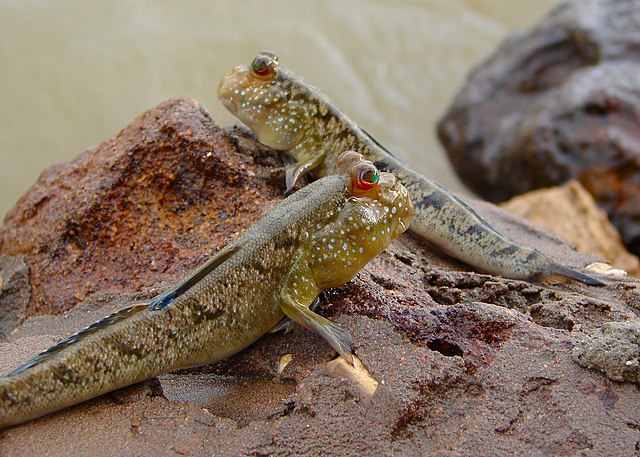Semiaquatic
Spends part of their time in water, or grows partially submerged in water From Wikipedia, the free encyclopedia
In biology, being semi-aquatic refers to various macroorganisms that live regularly in both aquatic and terrestrial environments. When referring to animals, the term describes those that actively spend part of their daily time in water (in which case they can also be called amphibious), or land animals that have spent at least one life stages (e.g. as eggs or larvae) in aquatic environments. When referring to plants, the term describes land plants whose roots have adapted well to tolerate regular, prolonged submersion in water, as well as emergent and (occasionally) floating-leaved aquatic plants that are only partially immersed in water.




Examples of semi-aquatic animals and plants are given below.
Semiaquatic animals
Summarize
Perspective
Semiaquatic animals include:
- Vertebrates
- Amphibious fish; also several types of normally fully aquatic fish such as the grunion and plainfin midshipman that spawn in the intertidal zone
- Some amphibians such as newts and salamanders, and some frogs such as fire-bellied toads and wood frogs.
- Some reptiles such as crocodilians, turtles, water snakes and marine iguanas.
- Waterbirds, especially penguins, waterfowls, storks and shorebirds.
- Some rodents such as beavers, muskrats and capybaras.
- Some insectivorous mammals such as desmans, water shrews and platypuses.
- Some carnivoran mammals, including seals, otter and polar bears.
- Some marsupials, including the water opossum and the two lutrine opossums.
- Hippopotamuses.
- Indian rhinoceros.
- Water buffalo.
- Tapirs.
- Moose.
- Semiterrestrial echinoderms of the intertidal zone, such as the "cliff-clinging" sea urchin Colobocentrotus atratus and the starfish Pisaster ochraceus
- Arthropods
- Aquatic insects (e.g., dragonflies) with at least one non-aquatic life stage (e.g., adults), or amphibious insects (e.g., amphibious caterpillars or the ant Polyrhachis sokolova).[note 1] Members of the hemipteran infraorders Gerromorpha and Nepomorpha occupy a variety of semiaquatic and aquatic niches, with many of the former locomoting on the water surface; a few of these are marine (e.g., Halobates, Hermatobates).
- Semiaquatic springtails, such as Anurida maritima
- Semiterrestrial malacostracan crustaceans (e.g., many crabs, such as Pachygrapsus marmoratus,[note 2] some amphipods, such as Orchestia gammarellus, some isopods, such as Ligia oceanica and some barnacles, such as Balanus glandula)
- Horseshoe crabs are mostly aquatic but spawn in the intertidal zone; juveniles live in tidal flats
- Semiaquatic spiders, such as Ancylometes or Dolomedes (these are distinct from the almost fully aquatic Argyroneta)
- An amphibious centipede, Scolopendra cataracta
- Semiaquatic annelids, such as the earthworm Sparganophilus
- Molluscs
- Intertidal bivalves, such as Enigmonia, which lives on mangroves
- Intertidal chitons, such as Acanthopleura granulata
- Semiterrestrial gastropods, such as the intertidal Patella vulgata, a limpet; also amphibious freshwater and marine snails, such as Pomatiopsis or Cerithideopsis scalariformis, respectively
- Semiterrestrial flatworms of the intertidal zone, such as the acotylean Myoramyxa pardalota[4]
Semiaquatic plants


- Semiaquatic angiosperms (e.g., mangroves, reeds, water spinach and the entire order Nymphaeales)
- Semiaquatic conifers, such as pond cypress
- Semiaquatic ferns, such as Pilularia americana
- A semiaquatic horsetail, Equisetum fluviatile
- Semiaquatic quillworts, such as Isoetes melanospora
- Semiaquatic club mosses, such as Lycopodiella inundata
- Semiaquatic mosses, such as Sphagnum macrophyllum
- Semiaquatic liverworts, such as Riccia fluitans
Notes
- At least one individual of a normally fully terrestrial praying mantis species, Hierodula tenuidentata, has learned to opportunistically prey on fish.[1]
- Technically, most land crabs fall into this category, since most must return to bodies of water to release their eggs; the few exceptions, such as members of genus Geosesarma,[2] are found among the Grapsidae (sensu lato) and Potamoidea (sensu lato).[3]
References
Wikiwand - on
Seamless Wikipedia browsing. On steroids.
